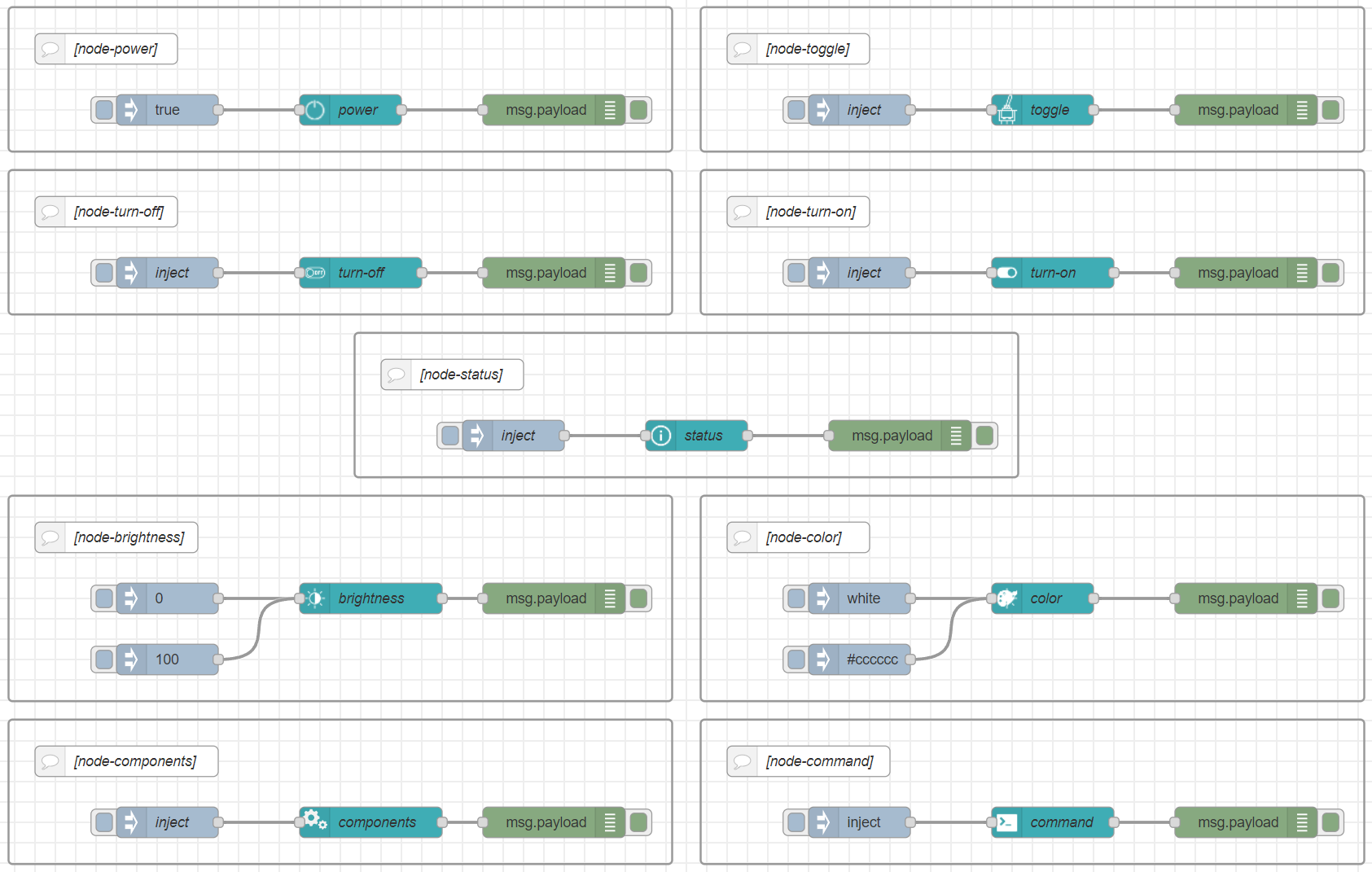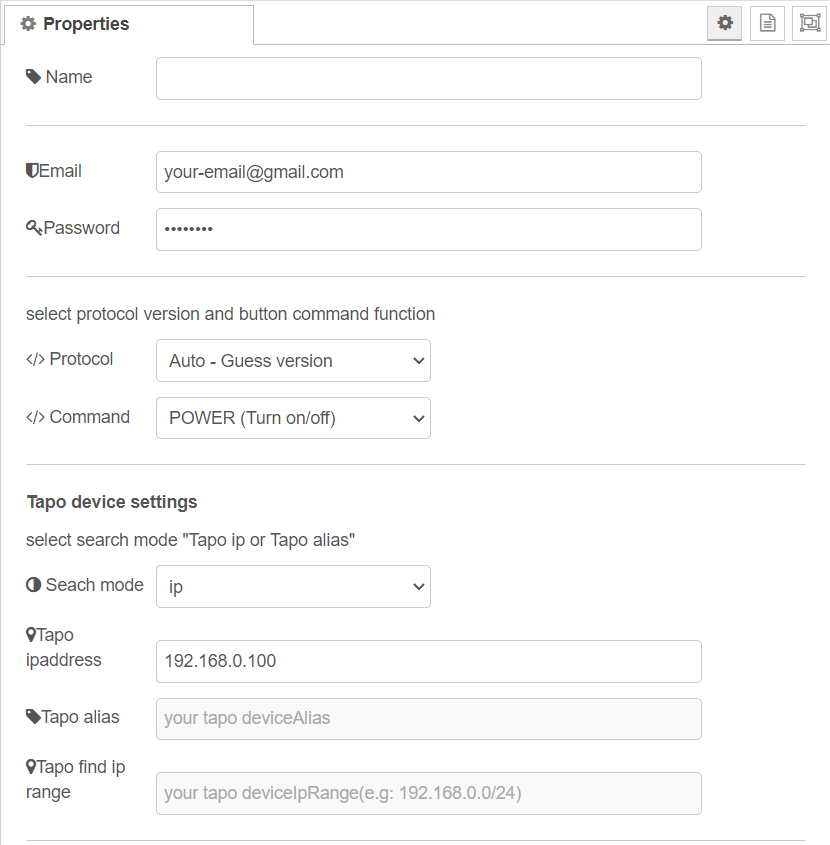node-red-contrib-tapo-new-api
Unofficial node-RED node for connecting to TP-Link Tapo devices with new interface (KLAP) and previous one (PASSTHROUGH). Currently limited to the:
- P100, P105, P110, P115 smart plugs
- L510E, L530E smart bulbs
- L900-10 smart strip
Node command options
-
power
This node command provides the ability to power (on / off) the device by input
"msg.payload"(boolean) -
toggle
This node command provides the ability to toggle (on / off) the power of tapo smart plugs.
-
turn-on
This node command provides the ability to power on tapo smart plugs.
-
turn-off
This node command provides the ability to power off tapo smart plugs.
-
brightness
This node command provides the ability to set the brightness of tapo smart bulbs.
-
color
This node command provides the ability to set the color of tapo smart bulbs.
-
status
This node command provides the ability to get the device infomation of tapo smart plugs. Models that can monitor energy acquire energy information.
"output: msg.payload.tapoDeviceInfo, msg.payload?.tapoEnergyUsage(P110 only)"will provide the device information and usage (if device can measure energy). -
components
This node command provides the ability to get the device components information.
-
command
This node command provides the ability to set a customized request to the device by input
"msg.payload"(TapoRequest object):{"method": string, "params": {"key": value, ...}}should be provided as valid request.
Node configuration by message (msg)
You can always override the node command configuration by means of the following message properties:
-
"msg.config.command"takes an string with one of the following valid command optionstype command_type = "status" | "power" | "on" | "off" | "toggle" | "color" | "brightness" | "components" | "command";
-
"msg.config.version"takes a number indicating the protocol(1 - PASSTHROUGH, 2 - KLAP, 3 - AUTO)
-
"msg.config.verbose"takes a boolean indicating the error verbose.When verbose is selected a
"msg.payload.errorInf.track"object is included. -
"msg.config.terninal_random"takes a boolean indicating the terminal to use.When terminal_random is
truea random terminal valid UUID is used (useful when various buttons are configured to attack same device).
Pre-requisites
The node-red-contrib-tapo-new-api requires Node.js v15.0.0 or higher to be installed.
Install
npm install node-red-contrib-tapo-new-apiUsage
-
Properties
-
Name
Set the node name displayed in the flow.
-
Email
Set the email address registered with Tp Link.
-
Password
Set the password registered with Tp Link.
-
Protocol
Set the protocol to be used in the communication with Tapo device.
-
Command
Set the kind of command the node will take as initial configuration.
-
Search mode
Select a search mode for the tapo device.
Usage
- ip : search by ip. (It's fast.)
- alias: search by alias and ip range.
-
Tapo ipaddress(
selected: ip)Set the IP address to the Tapo device.
-
Tapo alias(
selected: alias)Set the tapo device alias registered with Tp Link.
-
Tapo find ip range(
selected: alias)Set the IP range to search for Tapo device.
Usage
- case1: "192.168.0.1 to 192.168.0.25"
- case2: "192.168.0.0/24"
-
Inputs
msg
type search_mode_type = "ip" | "alias";
type command_type = "status" | "power" | "on" | "off" | "toggle" | "color" | "brightness" | "components" | "command";
type config {
email: string;
password: string;
deviceIp: string;
deviceAlias: string;
deviceIpRange: string;
searchMode : search_mode_type;
command?: command_type; /* Default: "status" */
version?: TapoProtocolType; /* Default: AUTO */
verbose?: boolean; /* Default: false */
terminal_random?: boolean; /* Default: false */
}
type payload: boolean /* power */ || string /* color */ || number /* brightness */ || TapoRequest /* command */[example1]
msg.config = {
"email": "your@gmail.com",
"password": "password",
"deviceIp": "192.168.0.xxx",
"command": "power",
"version": 3 /* AUTO */
}
msg.paylaod = true;[example2]
msg.config = {
"email": "your@gmail.com",
"password": "password",
"deviceIp": "192.168.0.xxx",
"command": "toggle",
"version": 2, /* KLAP */
"verbose": true
}[example3]
msg.config = {
"email": "your@gmail.com",
"password": "password",
"deviceIp": "192.168.0.xxx",
"command": "color"
}
msg.paylaod = "white";Outputs
The processing result is passed by msg.payload. It consists of an object that contains the following properties:
type TapoResuls = {
result: boolean; /* true: success, false: failure */
tapoDeviceInfo?: TapoDeviceInfo; /* Tapo device infomation */
tapoEnergyUsage?: TapoDeviceInfo | undefined; /* Tapo device energy if compatible */
tapoComponents?: Components | undefined; /* Tapo device components information */
tapoCommand?: Json_T | undefined; /* Tapo device results from "command" */
errorInf?: Error;
}[smart plug device infomation]
You can tell if the device is on or off by getting "device_on".
true: smart plug power on
false: smart plug power off
{
result: true,
tapoDeviceInfo: {
device_id: "*************"
fw_ver: "1.2.10 Build 20200609 Rel. 33394"
hw_ver: "1.0.0"
type: "SMART.TAPOPLUG"
model: "P105"
mac: "XX-XX-XX-XX-XX-XX"
hw_id: "*************"
fw_id: "*************"
oem_id: "*************"
specs: "JP"
device_on: false
on_time: 0
overheated: false
nickname: "3d printer power supply"
location: "XXXXXXXXXXXXXXXX"
avatar: "plug"
time_usage_today: 0
time_usage_past7: 0
time_usage_past30: 0
longitude: 0
latitude: 0
has_set_location_info: true
ip: "192.168.0.XXX"
ssid: "SSID"
signal_level: 0
rssi: 0
region: "Europe/Madrid"
time_diff: 0
lang: "es_ES"
},
tapoEnergyUsage: {
????
}
}npm-scripts
There are some npm-scripts to help developments.
- npm install - Install the testing environment in your project.
- npm run build - Make
./data/my-nodedirectory from thesrcdirectory and Install the my-node in Node-RED. - npm run start - Start Node-RED.
"http://localhost:1880"
File tree
[root]
│ package.json
│ README.md
│ tsconfig.json
│
├─data -> `Node-Red work files`
│ │
│ ├─my-node -> `project files` The resource files and built files should be placed here.
│ │ │ package.json
│ │ │
│ │ └─nodes -> The resource files and built files should be placed here.
│ │ └─...
│ │
│ └─node_modules
│ └─...
│
├─dist -> `The project built files`
├─examples -> `node-RED flow files`
├─figs
└─src
└─nodes -> project files
├─icons
├─lib
├─locales
│ ├─en-US
│ └─es-ES
└─test










